- MOE
- National Parks of Japan
- Yoshino-Kumano National Park
- Characteristics
main body
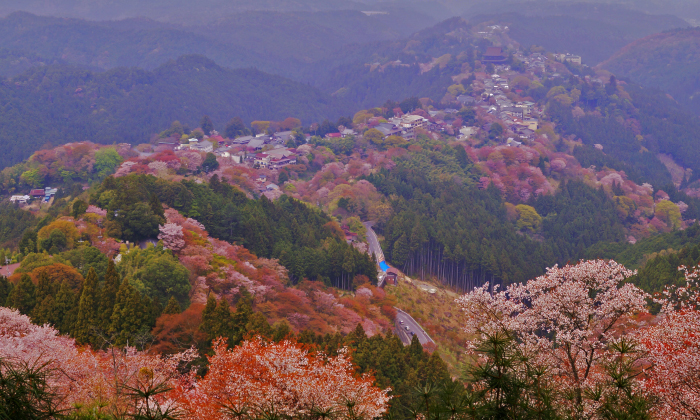
Characteristics
From the subtle and profound mountains, deep valleys to the southern sea where the Japan Current flows, visitors encounter the diversity of nature, unending history, and the culture of the Kii Peninsula
Date of Designation: February 1, 1936
Area: 61,406 ha (land area)
Related Prefecture: Mie, Nara, Wakayama
Area: 61,406 ha (land area)
Related Prefecture: Mie, Nara, Wakayama
Yoshino-Kumano National Park is a park of varied landscapes consisting of mountains, rivers, and beaches and encompasses the Omine Mountain Range, known as the Roof of the Kinki Region. The region stretches from north to south in the center of the peninsula with Odaigahara Plateau to the east; the Osugi Valley and the Kumano River from its source in these mountains to the Kumano-nada Sea; the middle and lower basin of the Kitayama River; the coastal line overlooking the southernmost Kumano-nada Sea from Owase to Cape Shionomisaki; and Mt. Nachi, which was protected over its long history by those who worshipped Kumano.
In addition, a portion of the area is designated a World Heritage site, named the "Sacred Sites and Pilgrimage Routes in the Kii Mountain Range" and a part of the northern area is designated as a UNESCO Eco Park aimed at the harmonization of preserving the ecosystems and ensuring sustainable utilization, as well as the Nanki Kumano area in Wakayama Prefecture is registered as the Japanese Geopark.
In addition, a portion of the area is designated a World Heritage site, named the "Sacred Sites and Pilgrimage Routes in the Kii Mountain Range" and a part of the northern area is designated as a UNESCO Eco Park aimed at the harmonization of preserving the ecosystems and ensuring sustainable utilization, as well as the Nanki Kumano area in Wakayama Prefecture is registered as the Japanese Geopark.
Terrain/ Scenery

Sheer Mountains
Mountainous Area
The Omine Mountain Range is a mountainous region representative of the Kansai region consisting of mountains rising 1,500 m to 1,900 m above sea level extending from north to south that includes Mt. Inamuragatake, Mt. Sanjogatake, Mt. Daifugen, Mt. Gyojagaeri, Mt. Misen, Mt. Bussho, Mt. Shakagatake, Mt. Dainichi, and Mt. Tengu with Mt. Hakkyogatake (1,915 m above sea level) as the highest peak.
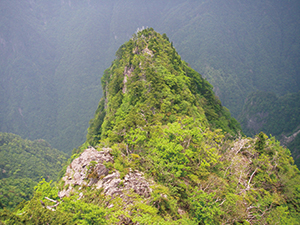
Breathtaking Views of Odaigahara Plateau (Viewed from Daijagura)
The area around Odaigahara Plateau is a non-volcanic elevated peneplain consisting of sedimentary rocks in the paleozonic strata, and Mesozoic strata, which is rare in Japan for having a vast flat topography, are found at around 1,500 m above sea level. The Higashinokawa River running through the area creates a deep V-shaped valley with a series of waterfalls and rock cliffs.
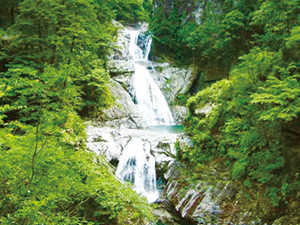
Nanatsu-gama Falls (Osugi Valley)(Copyright by Masahiro Mori)
The Osugi Valley is situated in the east of Odaigahara Plateau where the side of aqueous rock walls are largely eroded and the streams flow downward. There are also a hundred small and large falls and deep pools along the Osugi Valley including Senpironotaki Falls, Nikoniko Falls and Nanatsugama Falls.
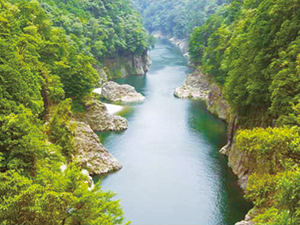
Dorokyo Gorge
River Area
The area around Omine boasts Japan's highest amounts of rainfall, and Odaigahara Plateau collects the bounty of water while the Kumano River empties into the Kumano-nada Sea. The middle and lower basin of the subsidiary Kitayama River created a deep V-shaped valley through powerful erosion throughout the area. The Dorokyo Gorge located midstream of the Kitayama River is a gorge situated downstream basin of the Kitayama River, which is a tributary of the Kumano River fed by waters flowing down from the Omine Mountain Range and Odaigahara Plateu. The gorge is divided into several sections from upstream to downstream: Oku-Doro, Kami-Doro, and Shimo-Doro. Shimo-Doro is also referred to as Doro-Haccho. This area features a diverse array of linked scenic elements consisting of vertically sheared cliffs created through the erosion of geological layers formed by the solidification of magma, oddly shaped rocks, and deep pools of water. Board a hovercraft or other vessel to explore the beautiful allure of this extraordinary gorge.
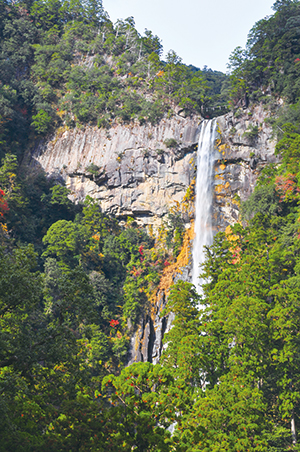
Nachino-Otaki Falls
Mt. Nachi Area
This mature mountainous region consists of Mt. Myoho and Mt. Eboushi and it was formed after granite porphyry intruding into a tertiary deposit remained due to the delayed encroachment compared to other mountains. The famous Nachi Falls, the tallest waterfall found in Japan with a height of 133 m, flow down the face of a steep cliff between both geological layers.
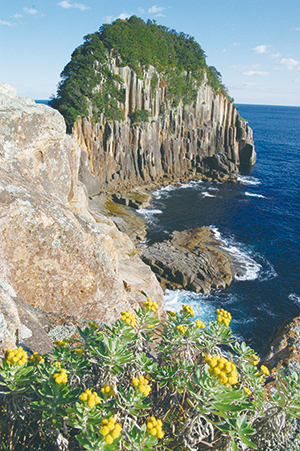
Tategasaki
Coastal Area
Having fewer flat ridges, the steep mountains in the mature stage are right at the water, creating a place where sea cliffs are well developed due to strong waves of the Kumano-nada Sea along the coast.Due to repeated patterns of sedimentation and prominence, the coastal line became complicated and varied, exhibiting diverse coastal topographies of submerged beaches, shingle beaches, and coastal terraces.
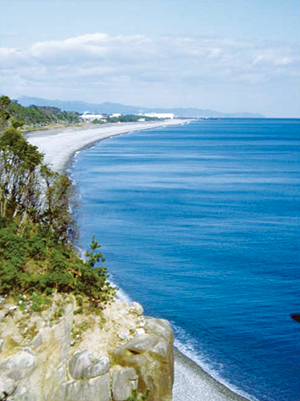
Oujigahama Beach
The areas from Owase to Onigajo form a typical complex coastline extending from the Shima Peninsula, and there are small to large indents throughout. By contrast, Shichiri-mihama Beach and Oujigahama Beach extending from Onigajo to Shingu City form a straight-line raised beach which is a shingle beach where flat land spreads along the ocean.
The coastal line from the periphery of Katsuura to the Uragami Peninsura forms a complex coastline showing complicated landscapes with numerous indentations.
The coastal line from the periphery of Katsuura to the Uragami Peninsura forms a complex coastline showing complicated landscapes with numerous indentations.
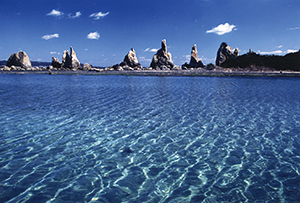
Hashigui Rock (Copyright by Kushimoto Town)
Cape Shionomisaki is a land-tied island situated in the southernmost of the mainland where a flat sea plateau spreads to exhibit coastal terraces. The Oshima Island floating on the east also has coastal terrace. Along with the Cape Shionomisaki , the south of the coastal line has varied indentations and well developed sea cliffs.
Plants
The east of Odaigahara Plateau (commonly known as the Nishiodai region) is an upheaval semi-plain where an extensive forest of Japanese beech trees grow. As an existing forest of beech trees along the Pacific seaboard of Japan, it is the largest forest in Japan and is thus considered precious as a research area. In addition, as with the Omine Mountain Range, there is the southern limit of spruce forest along the ridge line of Mt. Hidegatake.
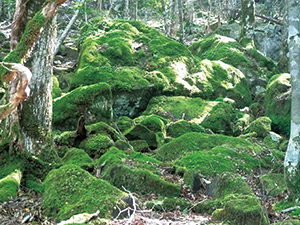
The Omine Mountain Range is lined with Veitch's silver fir, Tsuga diversifolia, and spruce trees in the vicinity of the summit of Mt. Hakkyogatake and part of the area is designated a natural treasure.
Affected by the Japan Current, this area is a suitable habitat for warm-season orchids and ferns, as well as the northern limit for Histiopteris incise, Asplenium antiquum Makino, Pteris fauriei, Ipomoea pes-caprae, Crinum asiaticum L. var. japonicum, Ipomoea indica, and other warm-season plants.
Affected by the Japan Current, this area is a suitable habitat for warm-season orchids and ferns, as well as the northern limit for Histiopteris incise, Asplenium antiquum Makino, Pteris fauriei, Ipomoea pes-caprae, Crinum asiaticum L. var. japonicum, Ipomoea indica, and other warm-season plants.
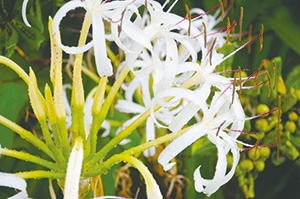
Crinum asiaticum L. var. japonicum
Wildlife
The natural forests on the hillsides of Odaigahara Plateau, Osugi Valley, and the Omine Mountain Range make for a perfect habitat for mammals, birds, and insects. In particular, the mammals found here are large animals including Cervus nippon, Capricornis crispus, and Ursus thibetanus, as well as small and medium-sized animals that include Macaca fuscata, fox, Sciurus lis, Lepus, Mustela itatsi, and Nyctereutes procyonoides, all of which are mostly the mammals living in Japan.
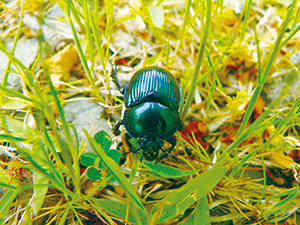
G. auratus auratus Motschulsky
The coastal area is home to numerous seabirds, especially the islands and capes along the Kumano and Owase beaches where there are breeding grounds of Ardea cinerea, Egretta sacra, and Apus pacificus. Additionally,as the area is close to the Japan Current, Scleractinia and schools of tropical fish make their abode creating unique underwater landscapes especially around Cape Shionomisaki and Nigishima Island.
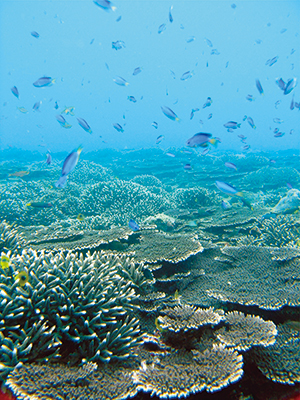
Corals
Cultural Landscape
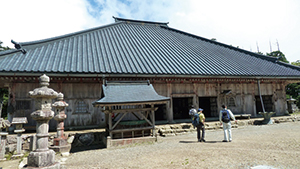
Spiritual mountain climbing to the Ominesan-ji Temple continues even now. (Mt. Sanjogatake)

Daimonzaka Stone Pave
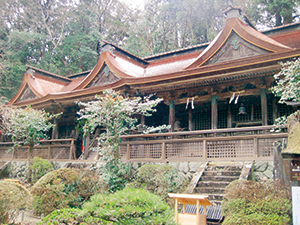
The Shrine Surrounded by Trees (Mikumari-jinja Shrine)
Yoshino-Kumano National Park encompasses a religious sacred place for the Omine Shugen and the Kumano worship that flourished from the medieval era to the early modern era holding a number of related historic sites and ruins.
There are old shrines and temples that remain and pass down old traditions throughout Mt. Yoshino, Dorogawa, Mt. Sanjogatake and Zenki, as well as Mt. Nachi called Kumano Sanzan, main, and new shrines.
There are old shrines and temples that remain and pass down old traditions throughout Mt. Yoshino, Dorogawa, Mt. Sanjogatake and Zenki, as well as Mt. Nachi called Kumano Sanzan, main, and new shrines.
